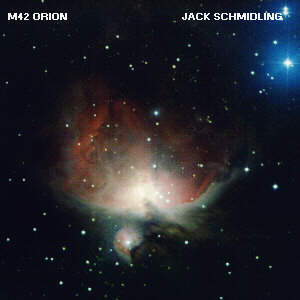![[picture of HorseHead]](horse.jpg)
Jack Schmidling Productions, Inc.
18016 Church Road ~ Marengo IL 60152
Email:jack@schmidling.com
| LATEST PHOTOS | MY FAVORITES | ASTROPHOTO INDEX | Galactic Photos | Extra-Galactic Photos | JSP Homepage |
| Photo of the Week | Barnard's Star | Orion Complex | Mars | M31 | Double Stars | M57 | M13 | Vesta |
| Pluto | The Eagle | Comet Hyakutake | Comet Hale-Bopp | The Moon | Yerkes Trip |
| Film Tips | Seeing | Video Imaging | CCD Imaging | Tasco Power | Veil Nebula | Astrograph |
I happen to think that "burnout" is a perfectly normal and healthy reaction to amateur astronomy. After all, how many times can a person look at the same fuzzy little patches and get excited? The usual next step is to show them to others but when the culmination of this effort is a less than resounding "oh, that's nice", it's time to move on.
I discovered astronomy around age ten while fishing on Lake Geneva with my father. We had to quit because of rain and he took us to Yerkes and I have been hooked (off and on) ever since. I built four scopes and still use the 4 1/4" mirror I made when age 13 in the guide scope for the 8" I made at age 21. Building scopes is one way to fend off the inevitable burnout but the end is always the same unless it becomes the end in itself.
Burnout need not mean selling the scope but it does demand doing something useful or interesting with it. You can define "useful and interesting" anyway you wish. Ham radio folks solved this problem with "contests", viz., see who can contact the most other hams in a given period of time. This is a bit artificial and akin to Messier marathons but it sells a lot of gear and magazines and keeps the mushbrains busy.
My scope had been in mothballs for years because of both burnout and living in Chicago. I dragged it out for the comet crash and have been charging ahead ever since. Between the internet and new technology, it was like a whole new ballgame. When I learned that we could make photos like the pros (well sort of) with small scopes, my enthusiasm knew no bounds.
Now when I show someone a fuzzy little patch, I also show them a photo taken with MY telescope, the very same one they are looking through and make a far greater impression than if it were a Palomar photo.
It is truly awesome what can be done with a small scope and modern film technology and a far cry from the "that's nice" syndrome of visual use. I have a lot to learn yet but I am on my way and now my biggest enemy is the weather and not boredom.
js
![[picture of HorseHead]](horse.jpg)
H
orsehead Nebula in Orion
This photo was taken through the 16" Newt at prime focus on Hypered TechPan.
The exposure was 30 minutes and guiding was with an ST-4. The film was developed in D19 developer for 5 min.
: If these images do not look like something you would be proud of, try clicking on your right mouse button and select "View Image". If that fails, see my notes at the end of this page.

M
42, the Orion Nebula
This photo was taken through the 16" Newt at prime focus on PF400 color film.
One of the first astrophotos I had ever taken, is still one of my favorites and one that is hard to improve upon. It was taken with the 4 x 5 press camera mounted piggyback on my 8" riding on my then new mount. The photo that follows was taken with the 90 mm astrograph and brings out the Pelican Nebula which is not visible in the first photo. I noticed another interesting feature which I never heard mentioned before and I call it the "Lady in Canada". Looking at archival photos, I have no trouble finding it but it really gets spooky when enlarged.
![[plato]](nanag.jpg) |
![[Copernicus]](nalady.jpg) |
North America Nebula |
Lady in Canada |
![[picture of VEIL]](veil.jpg)
T
he Veil Nebula in Cygnus
This photo was at the prime focus of the 8" Newt with a Lumicon Deep Sky filter on Hypered TechPan.
The exposure was 60 minutes and guided. The film was developed in D19 developer for 4 min.
Click here for High Resolution 16" photo
![[picture of M13]](m13m.jpg)
M
13, The Great Globular Cluster in Hercules
![[picture of Helix]](helix.jpg)
N
GC 7293
The Helix Nebula in Aquarius
This photo was taken through the 16" Newt at prime focus on Hypered TechPan.
The exposure was 40 minutes and guiding was with an ST-4. The film was developed in D19 developer for 4 min.
When first viewing these web pages, I was very disappointed with the results. Seemed like my trophy photos were processed by a 50's vintage scanner and most of the detail was lost. After much frustrating hacking, I found that the display driver in my computer had to be set to something called "Compaq 640 280 16.8m. - True Color" The default driver "VGA" with only 256 colors was the culprit.
Not quite sure what all that does but the result is that the photos look at least as good as when they were scanned. Not the same as the original but good enough for discussion purposes.
So if you have problems seeing the images with good resolution, look to your display driver.
js
.